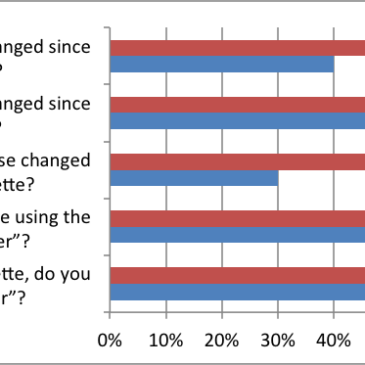Electronic cigarettes (e-cigarettes), introduced to the American market in the beginning of the 21st century, are battery-operated vaporizers that allow users to inhale vaporized nicotine without any combustion or smoke. They are lauded as useful tools in smoking cessation because they simulate both the chemical and behavioral aspects of smoking, without the physical harms that accompany tobacco smoke. This week’s ASHES reviews one of the first naturalistic observation studies to examine smoking and vaping behaviors and change in health status among current cigarette smokers who initiate e-cigarette use (Berg, Barr, Stratton, Escoffery, & Kegler, 2014).
Methods
- Researchers conducted a small, longitudinal pilot study surveying participants over time.
- Participants were selected because they were frequenting e-cigarette stores in the southeastern US.
- Participants had been smoking regularly for at least a year but had never used e-cigarettes (“vaped”) prior to enrolling in the study. Therefore, all participants had decided, on their own, to start using e-cigarettes.
- Thirty-six participants completed the baseline survey. Of these, 30 (83.3%) completed the Week 4 survey, and 26 (72.2%) completed the Week 8 survey.
- At Baseline, Week 4, and Week 8, participants described:
- Their smoking/vaping behavior (e.g. frequency of smoking and vaping in the previous 30 days)
- Whether they experienced improvement in a number of health symptoms between Week 4 and Week 8. Improvement was operationalized as answering “better,” instead of “the same,” to a series of statements such as, “If you had a smoker’s cough before using the e-cigarette, is it now…” or “How has your sense of smell/taste changed since using the e-cigarette”)
- At Weeks 4 and 8, the researchers measured participants’ cotinine levels[1] in saliva as an additional biomarker assessment of nicotine exposure.
Results
- The proportion of participants still smoking dropped from 90% at Week 4 to 76.9% at Week 8. Those who did keep smoking throughout the study tended to smoke fewer cigarettes and less often at Weeks 4 and 8, compared to baseline.
- Cotinine levels trended downward over time, consistent with the notion that participants were decreasing their overall nicotine consumption.
- Participants also indicated improvement on a number of health symptoms from Week 4 to Week 8. See Figure 1.

Figure 1 Percent of clients experiencing improvement in health symptoms at Weeks 4 and 8. Adapted from Berg et al. (2014). Click image to enlarge.
Limitations
- This was a small pilot study, which means that the researchers had limited statistical power to detect significant differences. We should consider these results as a way to highlight questions for future research.
- The authors used a convenience sample, limiting the generalizability of its results.
- The study relied mostly on self-report of smoking/vaping habits and as such was vulnerable to social desirability bias.
Conclusion
The results of this study suggest a number of perceived health benefits of initiating vaping during smoking cessation. Participants smoked less and tended to consume less nicotine during their first two months of e-cigarette use. In addition, participants tended to use e-cigarettes less over time, suggesting that they successfully tapered their overall nicotine consumption in a controlled fashion. Still, e-cigarettes might produce hidden harm; in animal testing, e-cigarette vapor had the potential to impair immune function, leading to morbidity, and mortality. Additional research is needed to examine longer-term effects of e-cigarette use in humans, both hidden and perceived.
–Emily Shoov
What do you think? Please use the comment link below to provide feedback on this article.
Reference
Berg, C.J., Barr, D. B., Stratton, E., Escoffery, C., & Kegler, M. (2014; available online 2015). Attitudes toward E-Cigarettes, Reasons for Initiating E-Cigarette Use, and Changes in Smoking Behavior after Initiation: A Pilot Longitudinal Study of Regular Cigarette Smokers. Open Journal of Preventive Medicine , 4(10): 789–800
________________
[1] “Cotinine,” an anagram of “nicotine,” is used as a biomarker for exposure to nicotine; it is the result of metabolizing nicotine.




